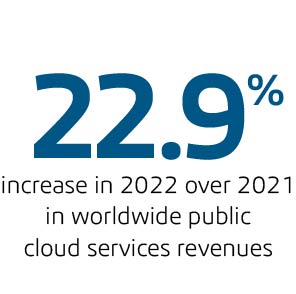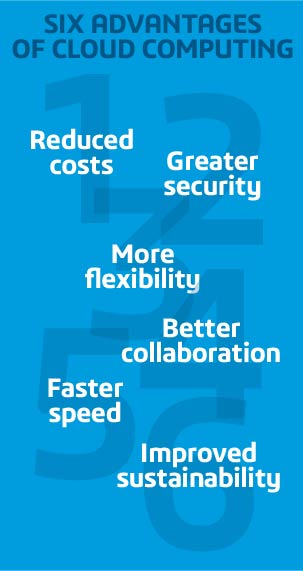Analyst firm Gartner predicts that by 2025 enterprise IT spending on cloud computing will overtake spending on traditional IT.
This shift has been gathering pace over the past 25 years, from a time when almost all applications and databases were stored on servers that were located at an organization’s own premises.
As individuals, we have become accustomed to using the cloud, whether we realize it or not, for a range of activities – from watching TV and communicating with friends to buying groceries and booking vacations.
Businesses of all sizes are increasingly realizing the benefits of cloud computing too. By replacing their on-premises services and systems with alternatives based in the cloud, they can focus on their core business while letting someone else take care of their technology requirements.
However, many organizations still have questions about the advantages and benefits of cloud computing – including what they can gain by moving software, platforms or even their entire infrastructure to the cloud.
What is cloud computing?
Before examining the benefits of cloud computing in more detail, it is worth spending a bit more time considering exactly what is cloud computing.
There are many different definitions of cloud computing, but in general, it is thought of as on-demand access, via the internet, to computing resources such as software, hardware, databases, storage and networking. Typically, these resources will be managed by a cloud computing provider in their own data centers.
The concept of cloud computing can be traced back to relatively early days of network computing, even before the internet was conceived. However, the term ‘cloud computing’ started to be used in the mid-1990s, by technology businesses like Compaq who saw the potential for file storage via the internet.
Around the same time, companies including AOL, Yahoo and Microsoft began to offer internet email services. This allowed users to access email applications via a web browser, rather than having to purchase an application and install it on their device, and then manage ongoing updates.
The explosion in smartphone usage also saw consumers downloading simple apps to their devices, providing a graphical user interface that connects via the internet to powerful applications that run on servers in remote data centers.
Amazon, Microsoft and Google were quick to recognize the potential of the cloud for organizations of all sizes, and the new cloud-based business IT model began to take hold in the 2000s. Cloud computing has become a cornerstone of their businesses, in the form of their Amazon Web Services, Microsoft Azure and Google Cloud offerings.
Many organizations began a journey of digital transformation, replacing manual and sometimes paper-based processes with automated and digital ones, often relying on data storage and processing power in the cloud.
The global Covid-19 pandemic led to a surge in uptake of cloud computing, as remote working became more popular and, in many cases, necessary for business to continue to function. In April 2020, Microsoft CEO Satya Nadella said: “We’ve seen two years’ worth of digital transformation in two months”. Businesses turned to cloud computing providers for remote teamworking services like Microsoft Teams and Zoom, and moved critical applications related to sales, customer service and business operations to the cloud.
Rapidly growing enterprise technologies including artificial intelligence and machine learning tend to involve huge amounts of data and therefore many organizations are turning to the cloud for initiatives in these areas due to its low initial cost and scalability.
Different types of cloud computing
There are now three primary types of cloud computing service model: software-as-a-service, platform-as-a-service and infrastructure-as-a-service. Respectively these provide application software, a ready-to-use platform for application development, or an entire back-end IT infrastructure in the cloud. Most large businesses will use a combination of all three models.

There are also three primary types of cloud computing architecture: public cloud, private cloud and hybrid cloud, which offer different levels of control, security and flexibility. Analyst firm IDC reported that worldwide public cloud services revenues surpassed $500 billion in 2022, a 22.9% increase on the previous year.
Check out our blog post “Cloud computing architecture: breaking down its components and more” to learn more about cloud computing service models and components of cloud computing architecture.
Which industries use the cloud?
Cloud computing is now widespread in all industries, with many applications of cloud computing – such as productivity, communication, and customer relationship management – required by organizations regardless of the sector they operate in.
However, it is important to note that most industries also have specific requirements that can be well served by cloud computing.
In manufacturing, for example, Industrial Internet of Things software collects huge amounts of data from machinery that can provide important insights into operations. This data can be gathered, stored, processed and analyzed in the cloud to deliver information on machine health, inventory management, energy efficiency and more. This enables manufacturers to transform their operations into ‘smart factories’.
Financial services firms can benefit from the cloud’s ability to handle large amounts of data quickly, meaning that transactions can be processed faster, more personalized services can be offered to customers, and fraudulent activity can be identified more easily.
In healthcare, the cloud is giving doctors and other medical practitioners better access to important information about patient health, from details of historic medical conditions to data generated in real-time from wearable health monitoring devices.
Cloud computing providers are now increasingly offering industry clouds – platforms designed to meet the specific needs of businesses operating in an industry segment including, for example, compliance and regulatory requirements. Gartner expects that by 2027, enterprises will use industry cloud platforms to accelerate more than half of their critical business initiatives.
Six advantages of cloud computing
If a cloud migration is managed carefully and successfully, there are many potential benefits of cloud computing. Below we provide some detail on six of the most cited advantages of cloud computing.

1. Reduced costs
Cloud computing removes the cost associated with organizations buying and maintaining IT services on their premises or even establishing their own data centers. In addition to saving cost on hardware, cloud computing removes the need for space, energy and expertise required to maintain an on-site IT infrastructure. Specialist cloud computing providers are in a position to offer comparable or better services at a lower cost because it is their area of specialism, and they can gain economies of scale because they provide similar services to potentially thousands of customers.
2. Greater security
Cloud computing comes with a range of security features, such as two-factor authentication and data encryption. Cloud providers devote considerable resources to ensure their infrastructures is protected against the threat of cyberattacks. They offer automatic maintenance and centralized management capabilities to deliver a consistent level of protection and ensure any abnormalities are detected, flagged and resolved quickly. Cloud computing systems also come with backup and disaster recover features, meaning data can be easily recovered in the event of an emergency, such as a hardware malfunction, a data breach or simple human error. This gives users more peace of mind and removes the need to make their own back-ups.
3. More flexibility
With cloud computing, organizations can quickly scale up their processing power and storage requirements to meet their changing business demands. Likewise, if resources aren’t being used then the organization can scale down with ease – only paying for the capacity they use. Cloud computing can also make it easier to turn on additional functionalities – for example, services relating to artificial intelligence or data analytics – as and when it is needed.
4. Better collaboration
As more organizations offer a blend of office-based, remote and hybrid working, they also need to ensure that employees – and potentially partners and customers – can access and share files, documents and data and use business applications from any location they may be working. Cloud computing enables employees to access workplace data and systems in real time, as long as they have an internet connection. Cloud computing also provides the foundation for most videoconferencing solutions, which exploded in popularity as a result of the pandemic, and messaging services.
5. Faster speed
Cloud providers will typically offer better network performance and automatic upgrades so that systems operate faster than is realistically achievable for most in-house servers. With cloud computing, organizations can also react quicker to business changes and even roll out new products and services to customers in shorter timeframes than would be possible with a traditional IT model. This is possible because they can access greater processing power and new computing functionalities without having to plan, resource and implement infrastructure changes themselves.
6. Improved sustainability
Running on-premises servers consumes energy and ultimately will bring a requirement for disposal or recycling. Cloud computing means only using the processing power you need, and therefore eliminates consumption related to unused capacity of in-house systems. The major cloud providers all have ambitious targets for sustainability and already offset some or all of their energy consumption, providing organizations with the ability to meet their own net-zero goals in relation to computing. And because cloud computing applications are often deployed to replace manual or paper-based tasks, they also eliminate the carbon footprint of the activities they are replacing.
Switching over to the cloud
Companies should switch over to the cloud to allow them to reap the benefits of cloud computing and focus their time and resources on their own business, rather than the operational burden of managing in-house IT applications and infrastructure.
The Dassault Systèmes 3DEXPERIENCE platform on the cloudbrings together all aspects of its customers’ business on a single cloud-based innovation platform that delivers the many advantages of cloud computing.
The platform comes with a complete suite of apps and software covering a range of industry needs including design and engineering, simulation, governance and collaboration, manufacturing and operations, and marketing.
It allows users to work with more creativity, flexibility, speed and impact, all within a single environment.
Dassault Systèmes is devoted to helping its customers succeed with the 3DEXPERIENCE platform on the cloud with initiatives including a complete onboarding program, tailored to each organization’s needs, e-learning modules to help users master the solutions, and a dedicated community that offers personalized expert advice.
A new generation of Dassault Systèmes solutions is making it easier to reap the benefits of the cloud – including reduced costs, greater security, more flexibility, better collaboration, faster speed and improved sustainability.

